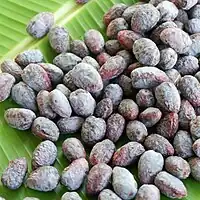| Terminalia microcarpa | |
|---|---|
.jpg.webp)  | |
| Top: T. microcarpa in Hawaii Bottom: Edible kalumpit fruits in the Philippines | |
| Scientific classification | |
| Kingdom: | Plantae |
| Clade: | Tracheophytes |
| Clade: | Angiosperms |
| Clade: | Eudicots |
| Clade: | Rosids |
| Order: | Myrtales |
| Family: | Combretaceae |
| Genus: | Terminalia |
| Species: | T. microcarpa |
| Binomial name | |
| Terminalia microcarpa | |
| Synonyms | |
|
Terminalia sericocarpa F.Muell. | |
Terminalia microcarpa is a tree species in the family Combretaceae. It occurs throughout the Philippines, in parts of Malaysia and Indonesia (Java, Sulawesi, Borneo, Timor, and the Maluku Islands), Papua New Guinea, possibly the Bismarck Archipelago, and northern Australia.[2][3][4] It is cultivated on a small scale in the Philippines, where the edible sweet and tart plum-like fruits are eaten as is or are traditionally made into jams, jellies, and wines.[5][6][7]
The species was formally described in 1834 by French botanist Joseph Decaisne. In the Australian Plant Census, Terminalia sericocarpa F.Muell. is regarded as a synonym of this species.[3] Common names in Australia include bandicoot, sovereignwood, damson and damson plum.[8] It is known as kalumpit in the Philippines.[9]
The tree typically grows to a height of 12 to 30 metres (39 to 98 ft) in height and is deciduous. It blooms between September and October producing cream flowers.[10]
It is found around springs and creeks and in rocky creek beds in the Kimberley region of Western Australia[10] and extending across the top end of the Northern Territory and tropical areas of Queensland growing in sandy-loam-clay soils.
See also
References
- ↑ Botanic Gardens Conservation International (BGCI) & IUCN SSC Global Tree Specialist Group (2019). "Terminalia microcarpa". IUCN Red List of Threatened Species. 2019: e.T62763A146622548. doi:10.2305/IUCN.UK.2019-2.RLTS.T62763A146622548.en. Retrieved 26 December 2022.
- ↑ "Terminalia microcarpa Decne". PROSEA. Retrieved 29 November 2021.
- 1 2 "Terminalia microcarpa". Australian Plant Name Index (APNI), IBIS database. Centre for Plant Biodiversity Research, Australian Government, Canberra. Retrieved 18 July 2013.
- ↑ "Terminalia microcarpa". Germplasm Resources Information Network. Agricultural Research Service, United States Department of Agriculture. Retrieved 18 July 2013.
- ↑ Ungson, L.B. (2001). "Character variation in Terminalia microcarpa Decne.: morphology and phenology of mature trees and early seedling growth". Asian International Journal of Life Sciences. 10 (1): 45–54.
- ↑ Aranas, Hannah (24 July 2012). "Terminalia microcarpa Decne". The Philippine Star. Retrieved 29 November 2021.
- ↑ "Kalumpit - Terminalia microcarpa". Fruitipedia. Retrieved 29 November 2021.
- ↑ F.A.Zich; B.P.M.Hyland; T.Whiffen; R.A.Kerrigan (2020). "Terminalia microcarpa". Australian Tropical Rainforest Plants Edition 8 (RFK8). Centre for Australian National Biodiversity Research (CANBR), Australian Government. Retrieved 3 June 2021.
- ↑ "Kalumpit, Terminalia microcrpa, Batangas Cherry: Philippine Medicinal Herbs / Philippine Alternative Medicine". www.stuartxchange.org. Retrieved 2017-03-10.
- 1 2 "Terminalia microcarpa". FloraBase. Western Australian Government Department of Biodiversity, Conservation and Attractions.
